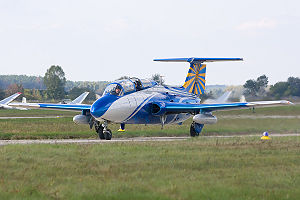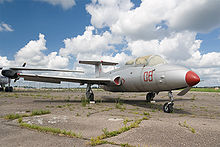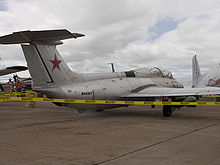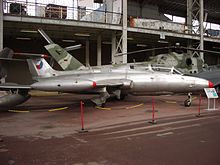- Aero L-29 Delfín
-
L-29 Delfín Aero L-29 Delfín Role Military trainer aircraft Manufacturer Aero Vodochody Designer Z. Rublič and K. Tomáš First flight 5 April 1959 Introduction 1961 Status At least a few in service with the Mali Air Force; popular civilian warbird Primary users Soviet Air Force
Czech Air ForceProduced 1963-1974 Number built 3,500 The Aero L-29 Delfín (English: Dolphin, NATO reporting name: Maya) is a military jet trainer aircraft that became the standard jet trainer for the air forces of Warsaw Pact nations in the 1960s. It was Czechoslovakia's first locally designed and built jet aircraft.
Contents
Design and development
In the late 1950s, the Soviet Air Force was seeking a jet-powered replacement for its fleet of piston-engined trainers, and this requirement was soon broadened to finding a trainer aircraft that could be adopted in common by Eastern Bloc air forces. Aero's response, the prototype XL-29 designed by Z. Rublič and K. Tomáš first flew on 5 April 1959, powered by a British Bristol Siddeley Viper engine. The second prototype was powered by the Czech-designed M701 engine, which was used in all subsequent aircraft.
The basic design concept was to produce a straightfoward, easy-to-build and operate aircraft. Simplicity and ruggedness were stressed with manual flight controls, large flaps and the incorporation of perforated airbrakes on the fuselage sides providing stable and docile flight characteristics, leading to an enviable safety record for the type. The sturdy L-29 was able to operate from grass, sand or unprepared fields. Both student pilot and instructor had ejection seats, and were positioned in tandem, under separate canopies with a slightly raised instructor position.
In 1961, the L-29 was evaluated against the PZL TS-11 Iskra and Yakovlev Yak-30 and emerged the winner. Poland chose to pursue the development of the TS-11 Iskra anyway, but all other Warsaw Pact countries adopted the Delfin under the agreements of COMECON.
Production began April 1963 and continued for 11 years, with 3,600 eventually built until 1974. A dedicated, single-seat, aerobatic version was developed as the L-29A Akrobat. A reconnaissance version with nose-mounted cameras was built as the L-29R.
Operational history
The Delfin served in basic, intermediate and weapons training roles. For this latter mission, they were equipped with hardpoints to carry gunpods, bombs or rockets, and thus armed, Egyptian L-29s were sent into combat against Israeli tanks during the Yom Kippur War. The L-29 was supplanted in the inventory of many of its operators by the Aero L-39 Albatros. More than 2,000 L-29s were supplied to the Soviet Air Force, acquiring the NATO reporting name "Maya."
L-29's, along with the newer L-39,were used extensively in ground attack missions in the Nagorno-Karabakh War by Azeri forces. At least 14 were shot down by Armenian air-defences.[1]
As a trainer, the L-29 enabled air forces to adopt an "all-through" training on jet aircraft, replacing earlier piston-engined types.
On July 16th, 1975, a Czechoslovak Air Force L-29 shot down a Polish civilian biplane piloted by Dionizy Bielański that was attempting to defect to the West.[2]
On October 2, 2007, an unmodified L-29 was used for the world’s first jet flight powered solely by 100% biodiesel fuel. Pilots Carol Sugars and Douglas Rodante flew their Delphin Jet at Stead Airport, Reno, Nevada in order to promote environmentally friendly fuels in aviation.[3]
Between September 10-14, 2008, two L-29s took first and second at the Reno Air Races. Both L-29s consistently posted laps at or above 500 miles per hour. Former Astronaut Curt Brown took first in "Viper," followed by Red Bull Racer Mike Mangold in "Euroburner."
Russia says it destroyed 2 Georgian L-29s during the 2008 South Ossetia war.[4]
Operators
 Afghanistan
Afghanistan- The Afghan Air Force operated as many as 24 from 1978 to as late as 1999.
 Azerbaijan
Azerbaijan- The Azerbaijani Air and Air Defence Force
 Armenia
Armenia- The Armenian Air Force
 Bulgaria
Bulgaria- Bulgarian Air Force operated 102 examples, delivered between 1963-1974, retired from service in 2002.
 Czechoslovakia
Czechoslovakia- The Czech Air Force operated as many as 400
 East Germany
East Germany- East German Air Force
 Egypt
Egypt- Egyptian Air Force - withdrawn
 Georgia
Georgia- Georgian Air Force
 Ghana
Ghana- Ghana Air Force
 Guinea
Guinea Hungary
Hungary- Hungarian Air Force
 Indonesia
Indonesia- Indonesian Air Force
 Iraq
Iraq- Iraqi Air Force - no longer operated
 Mali
Mali Nigeria
Nigeria- Nigerian Air Force
 Romania
Romania- Romanian Air Force - all the L-29 have been retired in 2006
 Uganda
Uganda- Ugandan Air Force
 Soviet Union
Soviet Union- operated as many as 2,000
- DOSAAF
- Soviet Air Force
 Slovakia
Slovakia- Slovak Air Force
 Syria
Syria- Syrian Air Force
 Tajikistan
Tajikistan- Tajik Air Force
 Vietnam
Vietnam- Vietnam People's Air Force
 United States
United States- United States Navy[5]
Civil operators
Australia : One private L-29C,VH-BQJ. Based near Sydney, New South Wales.
 Norway
Norway- Two L-29C, LN-ADA and LN-KJJ, operated by Russian Warbirds of Norway [1]
 Czech Republic
Czech Republic- One private L-29C, OK-ATS, Czech Jet Team Žatec - Macerka [2]
 Slovakia
Slovakia- One private L-29C owned by Ján Slota[3]
 South Africa
South Africa- Two Sasol Tigers aerobatic team flying the L-29
 United States
United States- THUNDERDELFINS L-29 Demonstration Team, [5]
 United States
United States- Two University of Iowa, Operator Performance Laboratory Used as high dynamics flight research aircraft for development of pilot state characterization [6]
Specifications (L-29)
Data from Jane's All The World's Aircraft 1971–72[6]
General characteristics
- Crew: 2: student and instructor
- Length: 10.81 m (35 ft 5½ in)
- Wingspan: 10.29 m (33 ft 9 in)
- Height: 3.13 m (10 ft 3 in)
- Wing area: 19.8 m² (213 ft²)
- Empty weight: 2,280 kg (5,027 lb)
- Loaded weight: 3,280 kg (7,231 lb)
- Max takeoff weight: 3,540 kg (7,804 lb)
- Powerplant: 1 × Motorlet M-701C 500 turbojet, 8.7 kN (1,960 lbf)
Performance
- Never exceed speed: 820 km/h (442 knots, 510 mph)
- Maximum speed: 655 km/h (353 knots, 407 mph) at 5,000 m (16,400 ft)
- Stall speed: 130 km/h (71 knots, 81 mph) flaps down
- Range: 894 km (480 nmi, 555 mi) with tip tanks
- Endurance: 2 hours 30 min
- Service ceiling: 11,000 m (36,100 ft)
- Rate of climb: 14.0 m/s (2,755 ft/min)
Armament
- 200 kg (440 lb) of various guns, bombs, rockets, and missiles on external hardpoints
See also
- Related development
- Aircraft of comparable role, configuration and era
- Related lists
- List of military trainer aircraft
References
- ^ http://www.acig.org/artman/publish/article_280.shtml
- ^ http://www.radio.cz/en/article/115295
- ^ http://www.scientificamerican.com/article.cfm?id=biodiesel-takes-to-the-sky
- ^ http://www.globalsecurity.org/military/world/georgia/af.htm
- ^ http://www.strategypage.com/htmw/htnavai/articles/20100629.aspx
- ^ Taylor 1971,p.29.
- Gunston, Bill, ed. "Aero L-29 Delfin." The Encyclopedia of World Air Power. New York: Crescent Books, 1990. ISBN 0-517-53754-0.
- Taylor, John W. R. Jane's All The World's Aircraft 1971–72. London:Jane's Yearbooks,1971. ISBN 0-354-00094-2.
External links
- (1961) Aero L-29 Delfin Flight Manual
- Czech Jet Team - civilian display team.
- Aircraft.co.za - The Complete Aviation Reference
- Warbird Alley L-29 Page
- Gauntlet Warbirds - L-29 Training in the Chicago Area
- Walkaround L-29 Delfin from Poltava
- Walkaround L-29 Delfin from Yegoryevsk
- Walkaround L-29 Delfin from Zaporozhye
Aircraft produced by Aero Vodochody Lists relating to aviation General Aircraft (manufacturers) · Aircraft engines (manufacturers) · Airlines (defunct) · Airports · Civil authorities · Museums · Registration prefixes · Rotorcraft (manufacturers) · TimelineMilitary Accidents/incidents Records Categories:- Aero Vodochody aircraft
- Czechoslovakian military trainer aircraft 1950–1959
Wikimedia Foundation. 2010.






